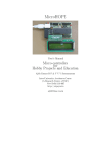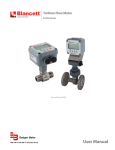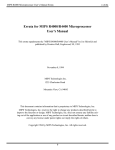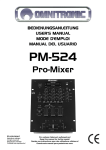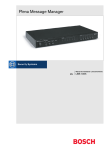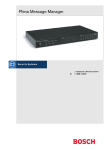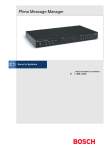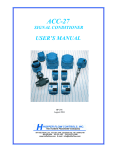Download Serial Bus Simulator (SBS) - User Manual - PEAK
Transcript
Serial Bus Simulator Data Stream Generator for Serial Bus Protocols User Manual Serial Bus Simulator – User Manual Products taken into account Product Name Model Item Number Serial Bus Simulator 1.1 IPEH-003050 Product names mentioned in this manual may be the trademarks or registered trademarks of their respective companies. They are not explicitly marked by “™” and “®”. © 2009 PEAK-System Technik GmbH PEAK-System Technik GmbH Otto-Roehm-Strasse 69 64293 Darmstadt Germany Phone: +49 (0)6151 8173-20 Fax: +49 (0)6151 8173-29 www.peak-system.com [email protected] Issued 2009-02-27 2 Serial Bus Simulator – User Manual Contents 1 1.1 1.2 1.3 2 2.1 2.2 2.3 2.4 3 3.1 3.2 3.3 3.4 3.5 4 4.1 4.2 4.3 4.4 4.5 5 Introduction 4 Properties at a Glance Prerequisites for the Operation Scope of Supply Connectors 4 5 5 6 USB Cable for Power Supply GND Socket CAN/LIN D-Sub Connector Pickoffs for Measuring Control Elements and LEDs Operating Mode (Rotary Switch) Analog (Potentiometer) Baudrate (Selector Switch) Traffic (Selector Switch/LED) Destroy (Push Button/LED) Transmission Behavior of the Data Sources CAN LIN V.24 I2C SPI 6 6 7 8 9 10 10 11 11 11 12 13 14 15 16 17 Technical Specifications 3 18 Serial Bus Simulator – User Manual 1 Introduction The Serial Bus Simulator (SBS) generates data streams for several serial bus types. The data streams can be used e.g. for demonstrations and validations of measuring systems. 1.1 Properties at a Glance Generates data streams for the following serial bus systems: • CAN • LIN • V.24 (RS-232) • I2 C • SPI 2 different transfer rates for each bus system Disengageable transmission of data frames Specific generation of defect data frames Pin assignment of D-Sub CAN connector according to CiA 102 DS Generation of an analog voltage for testing (e.g. trigger) Pickoffs for oscilloscope probes Desk-type casing Power supply via USB connection 4 Serial Bus Simulator – User Manual 1.2 Prerequisites for the Operation The following prerequisites must be given, so that the SBS can be used properly: Vacant USB port on an external device (e.g. measuring instrument, computer, power supply unit) for the power supply of the SBS (about 125 mA current consumption) 1.3 Scope of Supply The scope of supply normally consists of the following parts: Serial Bus Simulator (desk-type casing) with USB connection cable CD with user manual in PDF format 5 Serial Bus Simulator – User Manual 2 Connectors This chapter describes the pin assignment of each connector on the rear and on the control panel of the Serial Bus Simulator (SBS). 2.1 USB Cable for Power Supply The USB cable is used for the simplified connection of the power supply (5 V). The USB data lines are unused. Plug the USB connector into any USB port of an external device (e.g. measuring instrument, computer, power supply unit). The green LED at the rear of the casing is on, when the 5-Volt supply is present. The current consumption of the SBS is about 125 mA. 2.2 GND Socket In order to establish a ground connection between the SBS and a measuring set-up a 4-mm socket is available at the rear of the casing. A cable with banana plug can be used here (not included). 6 Serial Bus Simulator – User Manual 2.3 CAN/LIN D-Sub Connector The 9-pin D-Sub male connector on the rear of the casing includes the differential CAN signal (ISO 11898-2) and the LIN signal as well as a ground line. These signals are also available at the pickoffs on the control panel of the SBS. Figure 1: Pin assignment of the D-Sub male connector for CAN and LIN The CAN bus is terminated internally between the two signal lines CAN_L and CAN_H with 120 Ω. The SBS is configured as LIN master and the LIN bus is terminated with 1 kΩ accordingly. 7 Serial Bus Simulator – User Manual 2.4 Pickoffs for Measuring At the front of the control panel 17 pickoffs are available for measuring purposes. Figure 2: Pin assignment of the pickoffs on the control panel (description in the following table) Label Function Remark +5V Power supply 5 V Via 100 Ω, not intended to drive electrical loads GND Ground Analog Analog voltage 0 - 3.3 V from potentiometer Via 100 Ω, not intended to drive electrical loads SSEL SPI: Slave Select MOSI SPI: Master Out – Slave In MISO SPI: Master In – Slave Out SCK SPI: Serial Clock SDA I2C: Serial Data SCL I2C: Serial Clock RxD V.24/RS-232: Receive Data TxD V.24/RS-232: Transmit Data IO-0 GPIO-0 Reserved for future applications IO-1 GPIO-1 Reserved for future applications CAN_L CAN: Low signal CAN_H CAN: High signal GND Ground LIN LIN signal Reserved for future applications Reserved for future applications 8 Serial Bus Simulator – User Manual 3 Control Elements and LEDs This chapter describes the function of the control elements and LEDs on the Serial Bus Simulator (SBS). Figure 3: Layout of the control elements and LEDs 9 Serial Bus Simulator – User Manual 3.1 Operating Mode (Rotary Switch) The rotary switch activates one out of five sources for serial data: CAN (Controller Area Network) LIN (Local Interconnect Network) V.24 (standard for data remote transfer, related to RS-232) I2C (Inter-Integrated Circuit) SPI (Serial Peripheral Interface) In position OFF no serial data is generated. However, the SBS is still alive. Analog functions, like the 3.3 Volts at the potentiometer and the 5-Volt output, are active. The output of each data source is described in chapter 4 on page 12. 3.2 Analog (Potentiometer) The potentiometer has several functions: When generating data errors (Destroy push button), the position of the error within the data frame can be adjusted. The variable data byte within the data frames can be varied from 0x00 to 0xFF. A voltage from 0 to 3.3 Volts is provided at the pickoff Analog for measuring purposes. Note: The voltage at the pickoff Analog is not intended to drive electrical loads. 10 Serial Bus Simulator – User Manual 3.3 Baudrate (Selector Switch) The selector switch determines the transfer rate for each data source. The transfer rates are defined as follows: Data source CAN Transfer rate low high 125 kbit/s 1 Mbit/s LIN 9600 Baud 19200 Baud V.24 9600 Baud 19200 Baud I2C 100 kHz 400 kHz SPI 1 MHz 4 MHz 3.4 Traffic (Selector Switch/LED) When switched to On, additional data load is activated for the selected data source. Usually three frames are transmitted cyclically in turn every 50 ms. The green LED flashes in the rhythm of the additional frames being transmitted. 3.5 Destroy (Push Button/LED) By pressing this push button an additional frame with a protocol violation is generated. This frame should be recognized as erroneous at measurements (except for SPI). The red LED flashes, when an erroneous frame is transmitted (pressed push button). 11 Serial Bus Simulator – User Manual 4 Transmission Behavior of the Data Sources This chapter describes which data is transmitted by the data sources depending on the settings on the control panel. You'll find the information for CAN, LIN, V.24, I2C and SPI on the following pages. 12 Serial Bus Simulator – User Manual 4.1 CAN CAN data frames are generated, when the rotary switch Operating Mode is turned to the position CAN. The ACK bit (Acknowledge) is generated by the SBS itself, thus a listen-only operation is possible. The selector switch Baudrate changes the transfer rate to the value given on the control panel (125 kbit/s or 1 Mbit/s). When pressing the Destroy push button, the data source generates a correct CAN frame superimposed by a long dominant gap to force an error. The position of the dominant gap within the CAN frame can be adjusted with the Analog potentiometer. The gap length depends on the selected transfer rate. So, different types of errors are generated, e.g. CRC or Stuff errors. The transmitted CAN frame (without error) would be: CAN ID Length Data (hex) 0x00000666 (29 bit) 8 01 23 45 67 89 AB CD EF If the Traffic selector switch is in position On, three additional CAN frames are transmitted cyclically in turn every 50 ms: CAN ID Length Data Data (hex) 0x00000200 (29 bit) 4 “C” “A” “N” [Analog] 43 41 4E [00 … FF] 0x300 (11 bit) 6 “L” “e” “C” “r” “o” “y” 4C 65 43 72 6F 79 0x00000400 (29 bit) 4 “P” “E” “A” “K” 50 45 41 4B The value [Analog] is determined by the position of the Analog potentiometer. 13 Serial Bus Simulator – User Manual 4.2 LIN LIN data frames are generated, when the rotary switch Operating Mode is turned to the position LIN. The selector switch Baudrate changes the transfer rate to the value given on the control panel (9600 bit/s or 19200 bit/s). When pressing the Destroy push button, the data source generates a LIN frame with illegal header parity. The error is generated with the following composition: header parity XOR 0x40 The transmitted LIN frame (without error) would be: LIN ID Length Data (hex) 0x0F (15 dec) 4 00 55 AA FF If the Traffic selector switch is in position On, three additional LIN frames are transmitted cyclically in turn every 50 ms: LIN ID Length Data Data (hex) 0x1E (30 dec) 4 “L” “I” “N” [Analog] 4C 49 4E [00 … FF] 0x2D (45 dec) 6 “L” “e” “C” “r” “o” “y” 4C 65 43 72 6F 79 0x3C (60 dec) 4 “P” “E” “A” “K” 50 45 41 4B The value [Analog] is determined by the position of the Analog potentiometer. 14 Serial Bus Simulator – User Manual 4.3 V.24 V.24/RS-232 data frames are generated, when the rotary switch Operating Mode is turned to the position V.24. The data format is: 8 data bits, no parity bit, 1 stop bit (8N1) The selector switch Baudrate changes the transfer rate to the value given on the control panel (9600 bit/s or 19200 bit/s). When pressing the Destroy push button, the data source generates a 5 byte long frame with illegal stop bit in the third frame (“c”). The position of the Analog potentiometer doesn't have any influence on the generation of the errors. The transmitted V.24 frame (without error) would be: Length Data Data (hex) 5 61 62 63 64 0D “a” “b” “c” “d” CR If the Traffic selector switch is in position On, three additional V.24 frames are transmitted cyclically in turn every 50 ms: Length Data Data (hex) 5 “V” “2” “4” [Analog] CR 56 32 34 [00 … FF] 0D 7 “L” “e” “C” “r” “o” “y” CR 4C 65 43 72 6F 79 0D 5 “P” “E” “A” “K” CR 50 45 41 4B 0D The value [Analog] is determined by the position of the Analog potentiometer. 15 Serial Bus Simulator – User Manual 4.4 I2C I2C data frames are generated, when the rotary switch Operating Mode is turned to the position I2C. The selector switch Baudrate changes the transfer rate to the value given on the control panel (100 kHz or 400 kHz). When pressing the Destroy push button, the data source generates an 8 byte long frame with missing ACK bits at the characters “o” and “c”. The position of the Analog potentiometer doesn't have any influence on the generation of the errors. The transmitted I2C frame (without error) would be: Data Data (hex) 0xA0 0x00 0x00 “n” “o” “a” “c” “k” A0 00 00 6E 6F 61 63 6B The first three bytes represent the command “EEPROM write to address 0x0000”. If the Traffic selector switch is in position On, three additional I2C frames are transmitted cyclically in turn every 50 ms: Data Data (hex) 0xA0 0x01 0x00 “I” “2” “C” [Analog] A0 01 00 49 32 43 [00 … FF] 0xA0 0x01 0x80 “L” “e” “C” “r” “o” “y” A0 01 80 4C 65 43 72 6F 79 0xA0 0x02 0x00 “P” “E” “A” “K” A0 02 00 50 45 41 4B The value [Analog] is determined by the position of the Analog potentiometer. 16 Serial Bus Simulator – User Manual 4.5 SPI SPI data frames are generated, when the rotary switch Operating Mode is turned to the position SPI. Data is transmitted via the pin MasterOut-SlaveIn (MOSI). The pin MasterIn-SlaveOut (MISO) is not used by this application. The selector switch Baudrate changes the transfer rate to the value given on the control panel (1 MHz or 4 MHz). When pressing the Destroy push button, the data source generates a 4 byte long frame. Since the SPI bus doesn't have a stringent protocol, a frame cannot be destroyed and is therefore always decoded as correct. It can be used for trigger purposes. The transmitted SPI frame (always correct) is: Data Data (hex) 0x00 0x05 0x0A 0x0F 00 05 0A 0F If the Traffic selector switch is in position On, three additional SPI frames are transmitted cyclically in turn every 50 ms: Data Data (hex) “S” “P” “I” [Analog] 53 50 49 [00 … FF] “L” “e” “C” “r” “o” “y” 4C 65 43 72 6F 79 “P” “E” “A” “K” 50 45 41 4B The value [Analog] is determined by the position of the Analog potentiometer. 17 Serial Bus Simulator – User Manual 5 Technical Specifications Serial busses Simulated bus types CAN, LIN, V.24 (RS-232), I2C, SPI Supply Supply voltage +5 V DC ±5 % (via USB port) Current consumption about 125 mA Measures Size 120 x 45 x 155 mm (4 3/4 x 1 3/4 x 6 1/8 inches) (W x H x D) Weight 340 g (12 oz.) Environment Operating temperature 0 - +70 °C (32 - 158 °F) Temperature for storage and transport -25 - +85 °C (-13 - +185 °F) Relative humidity 15 – 90 %, not condensing 18


















